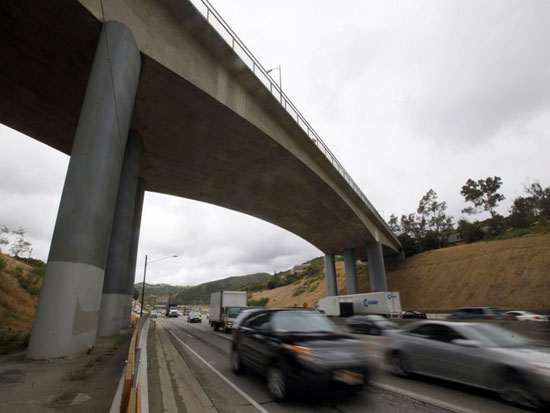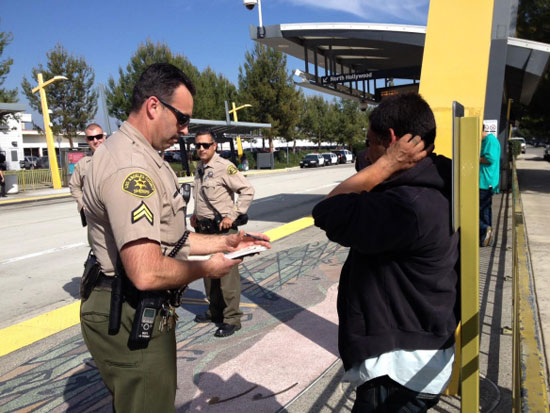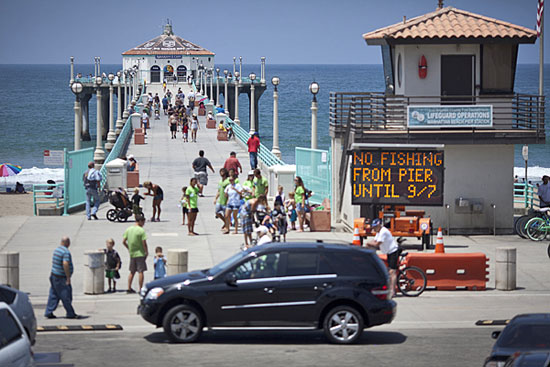405 bridge work causes a stink
July 24, 2014
The bridge that brought you Carmageddon is back in the spotlight this weekend—in a decidedly less dramatic role.
The Mulholland Bridge over the 405 Freeway will be closing on Friday and Saturday nights so that workers can seal the surface with a substance called methacrylate. The work is needed to coat “very small cracks” that have developed on the bridge surface. Methacrylate is a common though sometimes odiferous treatment for concrete decks.
“These aren’t structural defect cracks,” said Mike Barbour, who is Metro’s lead on the $1-billion-plus 405 Project, which is now virtually complete and is in its final “punch list” stage. Rather, he said, they are the kind of tiny cracks that can emerge when “the surface dried out too soon.”
The bridge will be closing from 10 p.m. Friday till 8 a.m. Saturday, with the pattern repeating on Saturday night through Sunday morning.
Beyond the detours, there’s this side effect: “An unpleasant odor may arise from this treatment,” according to a construction notice advisory sent out this week.
Few residents are likely to be troubled by the smell, however, Barbour said.
“There’s nobody really close by,” he said. “I seriously doubt that it’ll affect anyone.”
The Mulholland Bridge sparked a global media sensation in two Carmageddons during which it was demolished and completely rebuilt. The bridge work came as part of an ambitious effort to improve numerous elements of the 405 through the Sepulveda Pass while adding a 10-mile northbound carpool lane. The new lane opened in May.
Posted 7/24/14
A farewell to lawns
July 17, 2014
Start saying so long to the lawns of Southern California.
As the realities of climate change and drought have begun to sink in statewide, local figures indicate that homeowners have finally begun—gradually—to let go of their grass.
Amid new state conservation mandates and growing financial incentives, thousands of lawns and millions of square feet of green turf have disappeared during the last three years in Los Angeles County, much of it during the past year of record-low rainfall.
The reason? Outdoor irrigation is now consuming an estimated 50 percent of the average water bill.
This week, in an unprecedented action, the State Water Resources Control Board made it a statewide criminal infraction to waste water, particularly on landscape irrigation. Meanwhile, cities throughout the county have upped turf removal incentives encouraging homeowners to go drought-tolerant, at least in their front yards.
The moves have accelerated a trend that is already approaching critical mass in Southern California, even as they reorder a landscape that has long characterized the region.
“It’s slow, but things are really changing,” says Matthew Lyons, director of planning and water conservation for the Long Beach Water Department.
“Three of the last four years have been dry and this last winter was catastrophic. There’s just not a future here for grass lawns.”
Acceptance of that reality hasn’t been easy.
“People have had a hard time letting go of their beautiful green sward,” says Lili Singer, director of special projects and adult education for the Sun Valley-based Theodore Payne Foundation, a native plant organization that has done a land-office business this year helping county homeowners rethink their landscapes.
“Everybody on the block has the same setback and the same yard and people don’t want to be the oddball,” said Singer. “But there’s also this thing about having an estate.”
“It’s an enormously emotional thing,” agrees Stephanie Pincetl, director of the California Center for Sustainable Communities at UCLA. “People’s property values are tied up in it. And there’s the sort of iconic manliness in having a good-looking lawn that’s reinforced by TV programs and ads and all sorts of cultural messages.”
Generations of L.A. suburbanites can attest to this cultural attachment, whether they grew up tending the dichondra around a San Fernando Valley ranch house or assiduously edging the Bermuda grass at a Mid-Wilshire cottage.
Pincetl said that when she replaced the grass on the median strip of her small condominium complex last year with colorful, drought-tolerant plantings, a neighbor sent her a note accusing her of “threatening to destroy the aesthetic of the street and overpower the parkway.”
Cultural historian Ann Scheid says that aesthetic dates to the 1800s, to East Coast settlers who “imported their architecture from the East, and imported their lawns, too.”
Though a native plant movement did crop up here in the 1890s, she said, it didn’t catch on then because many of the large estates were second homes whose owners only visited during the winter.
By 1912, she noted, Los Angeles also had the L.A. Aqueduct, and, later, the Metropolitan Water District, which imports water from the Colorado River.
“So we never really had to face the problem,” she says. “Until now.”
Now, with climate change heating an already arid and densely populated region, conservation has become a mantra.
Some communities have been ahead of the curve: In Santa Monica, where no-grass lawns have become common, a pair of decade-old demonstration gardens have helped show the value of drought-tolerant landscapes, not just in water savings but in diminished labor and green waste.
The City of Los Angeles has imposed mandatory water conservation rules on homeowners since 2007, including alternating watering days and a ban on daytime lawn sprinkling. The city Department of Water and Power says the strategy has cut L.A.’s water use by 17 percent over the last seven years.
Also useful have been MWD’s conservation incentives and turf removal rebates, which have been increasingly adopted by member cities this year as the drought has worsened. The MWD rebate doubled in May to $2 per square foot, an incentive that can be augmented by member cities. In Los Angeles, the rebate is $3 per square foot; in Long Beach, it’s $3.50.
The program has prompted more than 1,900 L.A. homeowners to switch from grass to “California Friendly” landscapes during the past three years; in Long Beach, the toll has been 1,300 lawns, including 433 so far this year.
“I have a lot of cactus now, and perennials and lavender and lily of the valley,” says Long Beach resident Argy Abel, who took advantage of her city’s program two years ago, and is now one of three homeowners on her block alone to have gone grass-less.
Even smaller programs have made a mark: Though only a limited number of water users have qualified for the Los Angeles County Department of Public Works’ turf replacement program, the “Cash for Grass” incentive has made more than 250 grass lawns disappear, mostly in the Antelope Valley. And that’s not counting the people who went drought-tolerant on their own.
Still, some neighborhoods remain cautious. Beverly Hills, for example, not only has a longstanding lawn culture, but also supplies about 10 percent of its own drinking water through a municipal water treatment plant.
There, turf replacement incentives haven’t found many takers, though the city has had some luck with voluntary conservation and a high-tech, remote leak detection system, says City Manager Jeff Kolin. He says that with the new state mandates, “we’ll probably be adding some more incentives and enforcement.”
Good luck, says Peter Eberhard, a Westside landscape designer, who notes that wealthier homeowners tend to have bigger lawns and less sensitivity to the price of water.
“No one is calling us and saying, ‘Oh, I’m concerned about this drought, please take my lawn out’,” he laughed.
Posted 7/17/14
Tough audit sparks reforms
July 17, 2014
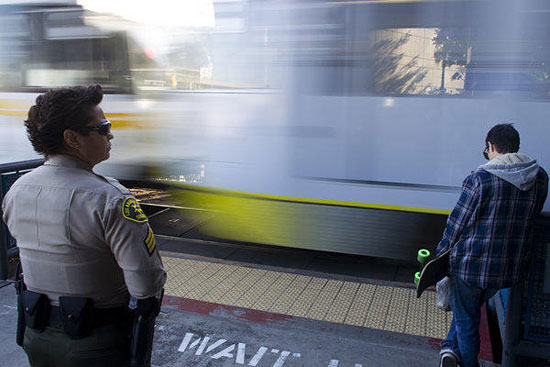
A sheriff's deputy keeps an eye on goings-on at a Blue Line platform last fall. Photo/Los Angeles Times
A hard-hitting new audit says the L.A. County Sheriff’s Department has failed to live up to its multimillion dollar contract to police the Metro system, while the transit agency itself has done a poor job of monitoring the sheriff’s performance.
The audit was commissioned by Metro’s Board of Directors last year and performed by the firm Bazilio Cobb Associates, with a team including members of the Bratton Group, LLC. The May 27 report faulted the sheriff on a number of fronts, including lack of a community-policing plan for the nation’s third-largest bus and rail system, perennial staff vacancies, tardy responses to citizen complaints and inadequate records to support its billings.
Overall, the audit determined that both the Sheriff’s Department and Metro had significant improvements to make.
“We found that Metro needs to substantially strengthen and enhance its oversight of LASD contract performance,” it said. “We found LASD has not met many of the targets for performance metrics, including crime reduction, continuity of staff, and fare enforcement saturation and activity rates.”
The audit was presented to Metro’s System Safety and Operations Committee on Thursday. CEO Art Leahy told the panel that new management at the sheriff’s department now has “an intense focus on delivering the goods here. There’s no finger-pointing, there’s no excuses. They can do better and Metro can do better.”
Sheriff’s Cmdr. Michael Claus, while disagreeing with a few of the report’s conclusions, said most of its 50 findings were on target.
“The bottom line is: we didn’t do what we should have done,” Claus said in an interview. “No one likes to be told they’re not doing a good job, but they were right in a lot of areas.”
Claus, who became Metro’s head of security in January, said reforms already are underway. Those include upgrading the Transit Services Bureau into a full-fledged sheriff’s division with its own chief, to whom Claus now reports. That move, effective July 1, will give structure to the team and enable it to advocate more effectively for staff resources, Claus said. It also may be a morale-booster for deputies assigned to the transit beat, which the audit said has been considered undesirable or even punitive by some within the department.
“By making it its own division, probably 20 people have removed their transfer requests,” Claus said.
The audit comes as the sheriff’s Metro contract—by far the department’s largest—is up for renewal. The new contract will likely be worth more than $400 million over five years, the report said. The department currently is working under a $42 million six-month contract extension that expires on Dec. 31.
The audit covered five years beginning July 1, 2009 and found lots of room for improvement. Among its findings:
- Critical information—such as up-to-date blueprints and maps of station layouts—needed in the event of an attack on Metro’s transit system has not been shared with key tactical response units within the sheriff’s department. (Claus, a former SWAT officer and commander, said an effort to provide up-to-date, digitized information is underway, but insisted that the sheriff’s units in question already are familiar with Metro facilities.)
- The transit security operation has operated with high levels of vacancies and too often sends in substitute staff without the necessary transit expertise.
- The department has double-billed for some supervisors’ time; billed Metro at the full rate even when managerial, supervisorial and support positions went vacant; failed to provide enough backup documentation of time being worked; and in fiscal 2011 submitted bills of $59,368 above the maximum amount allowed under the contract.
- Customer complaints against deputies often are not processed on time, and deputies with multiple complaints against them usually aren’t routed into the department’s “performance mentoring program.” (Claus said a backlog stretching to 2010 has now been eliminated.)
- Mobile phone validators used by deputies to check patrons’ TAP cards are technologically inadequate and can’t be used for basic crime-fighting tasks, such as looking for outstanding warrants when people are stopped for fare checks. Better fare-validation devices are being developed, the audit said, but other issues involving checking TAP cards remain unresolved—notably the question of whether that duty should be handled primarily by Metro’s own security staff rather than sworn deputies.
- Crime reporting and response time statistics are not being appropriately reported. (The department has switched, as recommended, to the FBI’s Uniform Crime Reporting standards, Claus said. He said the department disagrees, however, with a recommended change in reporting response times that would start the clock running when a Metro operator receives a call—not when it reaches the sheriff’s department.)
The audit also said the sheriff’s transit security team was not engaged enough in making quality of life improvements in Metro facilities.
But, according to the sheriff’s department, that finding overlooks a notable recent success story.
“Deputies have made tremendous strides in cleaning up Union Station; examining and solving delicate homeless rights issues, solving quality of life issues, making the area a cleaner, hazard-free experience for patrons, etc.,” according to the official response to the audit from interim Sheriff John Scott. “More is to be done, but to say that great strides have not been obtained would simply not be reflective of the current status.”
As for Metro, the audit found that the agency has failed to set forth adequate contractual requirements for the sheriff’s department, and has been lax about keeping tabs on the requirements that are in place.
In a response to the audit, Duane Martin, the agency’s deputy executive officer for project management, wrote that his department is asking for more staff to provide better contract oversight. He said Metro also will seek to modify its existing contract to enable it to seek damages if the sheriff doesn’t live up to specified performance targets—including crime reduction and continuity of staffing—and will write that into the next contract as well.
Beyond the audit, Metro CEO Leahy said he also has ordered a peer review of his agency’s security services by the American Public Transportation Association. Those findings will be examined, along with the audit, by Metro’s board this fall.
Posted 7/17/14
Looking at Valley rail and beyond
July 17, 2014
A push to transform the popular Orange Line busway into the San Fernando Valley’s first light rail line may also jumpstart a broader examination of what the next chapter in L.A. County transportation could look like.
Metro’s Board of Directors next week will consider a motion to study options for improving the Orange Line, along with the possibility of connecting the Orange, Red and Gold Lines with Burbank and Bob Hope Airport. But that motion—by L.A. City Councilmember Paul Krekorian, Mayor Eric Garcetti, Glendale City Councilman Ara Najarian, Supervisor Zev Yaroslavsky and Duarte Mayor John Fasana—has now prompted a related push to create a roadmap to update Metro’s long term plans for the entire county.
Taken together, both concepts, if approved by the agency’s full board, could begin to give shape to the list of projects that might be included in potential new transit sales tax measure that could be on the 2016 ballot.
“It has to be part of a transparent, inclusive and innovative long range planning process from which a new sales tax ballot initiative should emerge,” said Santa Monica Mayor Pam O’Connor, who proposed the countywide amendment along with Lakewood Councilmember Diane Dubois and Supervisor Don Knabe at Metro’s Planning and Programming Committee meeting this week.
The current push to investigate upgrades to the Orange Line comes after Governor Jerry Brown recently signed into law a bill permitting ground-level rail in the busway’s corridor.
Some have argued that other, less costly improvements are the best way to improve the Orange Line—which is carrying nearly twice the people originally projected and has been reaching capacity during rush hours.
But Coby King, board chairman of the Valley Industry and Commerce Association, the primary backer of the new state legislation, said converting the bus line to rail is the best way to serve the Valley’s 1.77 million residents.
“The problem is that the Orange Line has become a victim of its own success,” King said. “We believe that rail is the answer. Let’s do the objective study and let the chips fall where they will and we can make a decision on the facts—and a certain amount of equity.”
King added that Measure R, the original 2008 half-cent sales tax measure to fund transit projects, brought 36 miles of new rail to other parts of the county but left the Valley with none. For the region to support a new tax measure, additional rail lines for the Valley would have to be a part of the equation, he said.
At the committee meeting, Metro CEO Art Leahy weighed in on the big picture as well as the specific concerns of Valley residents.
“Without a doubt the number of projects is going to exceed the amount of money a measure is going to generate, so at some point we are going to have to sit down with the subregions and talk turkey about what goes in,” Leahy said.
Posted 7/17/14
Shark bite opens debate
July 10, 2014
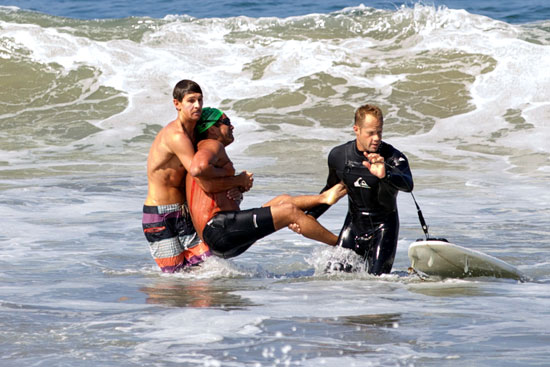
Steve Robles is pulled from the Manhattan Beach surf after his encounter with a snagged white shark.
The fisherman is off the hook. But his headline-grabbing behavior on the Manhattan Beach pier—when he snagged a young great white shark that thrashed and ended up biting a swimmer—is still churning up debate over how best to protect the beach-going public.
Manhattan Beach has quickly moved to ban all fishing from the pier for up to 60 days, although the California Department of Fish and Wildlife is weighing whether the city may have overstepped its authority on the state-owned pier. Meanwhile, Los Angeles County lifeguard officials have begun refining a new policy to create buffer zones between swimmers, surfers and the young sharks that increasingly are making Manhattan Beach their home before they head to deeper waters.
What’s more, officials now are being forced to confront an undercurrent of hostility that for years has strained relationships around the 94-year-old concrete pier, the oldest in California.
The sensational incident during the July 4th weekend—mistakenly characterized in early news reports as a shark attack—has exposed long-running complaints by surfers and swimmers that some pier fishermen have been endangering them. Among other things, they accuse fishermen of illegally “chumming”—dumping buckets of fish guts off the pier—to attract sharks.
“Tempers have been flaring,” said Los Angeles County Lifeguard Captain Kyle Daniels, who’s stationed in Manhattan Beach. “We do our best to separate the groups but it’s a dynamic situation. This goes back years.”
The Saturday incident brought it all to the surface, generating a wave of national news coverage and social media finger-pointing—most of it aimed at the fisherman and his friends, who were bombarded with allegations of animal cruelty and human indifference. The group was caught on video laughing and joking in the moments before they realized that a swimmer had been hurt by the distressed shark on the end of their high-gauge line. As of Thursday, the video had more than 1.4 million views.
According to witnesses, fisherman Jason Hagermann had been battling with the 7-footer for 45 minutes. The fish surfaced just as a group of distance swimmers passed while training for an upcoming pier-to-pier event. The victim, Steve Robles, can be heard on the video wailing as other swimmers rush to his rescue. Robles, a former L.A. County lifeguard himself, suffered serious but non-lethal gashes under his arm and along his side.

Juvenile great whites have been feeding in Manhattan Beach "like infants at an all-you-can-eat buffet."
Under state and federal law, it’s illegal to target great whites. If one gets hooked, then the line must be promptly cut. Hagermann told Fish and Wildlife investigators that he hadn’t been fishing for great whites and that he was afraid to cut the line while so many swimmers were nearby. With no evidence to contradict him, an agency spokeswoman said, no charges were filed.
Still, county lifeguard Daniels and others familiar with shark behavior insist the fish would never have bitten anyone had it not been fighting for its life. “If you lassoed and dragged a bear through a crowd,” he said, “I’m sure someone would get hurt.”
Daniels also said that the exceptionally strong wire-like line the fisherman was using posed a far greater danger to public safety than the juvenile shark. Had the fish quickly darted across and underneath the group of swimmers, “the line would have cut through to the bone.”
Laurie Jester, acting director of community development for Manhattan Beach, said the 60-day ban on pier fishing will give officials an opportunity to determine whether new restrictions should be imposed to avert these kinds of preventable risks.
“There’s a public safety concern with fishing on the pier,” she said, “and we want to make sure we’re covering all our bases, consulting with all the right people.”
The Los Angeles County Fire Department, which oversees lifeguard operations, has also moved in recent weeks to protect swimmers and surfers from potential harm.
Chief Daryl Osby said the department introduced a policy this summer to create “exclusionary zones” 300 yards into the water when sharks bigger than 8 feet are spotted because, unlike juveniles, these animals “can sometimes exhibit aggressive behavior, representing a public threat.” Osby said the department, in consultation with scientists at the Monterey Bay Aquarium, has developed a public education program “so beachgoers can become aware of the environment and habitat they’re about to enter.”
That habitat, scientists and others say, is increasingly a shared one, as rising numbers of young white sharks are taking up temporary residence at the popular El Porto surfing area, at Manhattan Beach’s northern end.
As a result, “the curious and the YouTube seekers” are boarding all sorts of crafts for a view of the sharks as they feast on the bay’s plentiful offerings, “like infants at an all-you-can-eat buffet,” said Manhattan Beach’s ex-mayor, Steve Napolitano, now a senior aide to Los Angeles County Supervisor Don Knabe, whose district includes the South Bay.
International big-wave rider Alex Gray, who’s also an avid fisherman, has been playing in the Manhattan Beach surf since he was a kid. He resents the human intrusions into the young white sharks’ habitat.
“Give the animals the respect they deserve and allow them to be at home,” he said the other day, as he looked out across the Pacific. “What if I walked into your house, took a picture of your family eating dinner and then walked out? Give respect, get respect. Just let them be.”
“I’ve traveled the world and I’ve never once had a bad encounter with a shark,” he added. “If I see a shark, I give it its area. I would never paddle up to it for a picture.”
Gray, 28, said the one thing that “breaks my heart” about the Manhattan Beach incident is that “kids might now be afraid to go into the ocean…I love this community more than anything. It hurts me when I see negativity that doesn’t need to be there.”
Posted 7/10/14
Green river milestone
July 10, 2014
Improving the Los Angeles River has become a local cause célèbre, with increasing numbers of Angelenos pushing to transform the concrete channel into a place where people can exercise, play and relax.
This Saturday, L.A. County takes a big step toward that goal when it opens the L.A. River Headwaters Project, which is located at the river’s official beginning—the convergence of Calabasas and Bell creeks in Canoga Park.
The $11.5 million project is the river’s largest greenway improvement so far, with 2.5 miles of upgrades that benefit the public and the environment. Cung Nguyen, the river’s watershed manager for the Department of Public Works, said the opening is an important milestone.
“If we improve the beginning and end of the river, then we can start filling in all the gaps,” Nguyen said. “Ultimately, the grand picture is to provide connectivity for recreation along the whole river.”
Joggers and bicyclists will gain access to 2.5 miles of new trails (1¼-mile in each direction) on which to ride and run, passing safely under street crossings and over pedestrian bridges. Rest areas with benches will provide pit stops for those who prefer to take a slower pace.
Native landscaping replaces the former backdrop of an access road and chain link fencing. It also creates new habitat for wildlife, including 300 species of migratory birds that rest their wings by the river. Maintenance crews have been trained to know when nesting seasons are so they won’t disturb the avian guests as they pass through.
The project is still designed to help prevent devastating floods while reducing the amount of urban runoff with bioswales—subsurface plant and sediment-filled structures that let water seep into the ground to be filtered naturally rather than getting fast-tracked, pollutants and all, into the ocean. Nguyen estimated that up to 587,000 gallons of water will be recaptured in an average year.
The headwaters project is funded by the county Flood Control District, along with a $1.8 million grant from Prop. 84, a state initiative dedicated to improving water systems. The project originated with the 1996 L.A. River Master Plan, which recognized the waterway’s importance as a natural resource and targeted publicly-owned lands for future projects. More than 50 of those projects have been completed to date, with another 50 or so to come. Coming up are more greenways like the headwaters project as well as things like wetlands, parks, bike paths and kayaking programs. Just last month, another San Fernando Valley greenway, the half-mile Valleyheart Riverwalk project, opened between Studio City and Sherman Oaks.
While those project-by-project efforts continue, a $1 billion revitalization plan approved by the Army Corps of Engineers in May is expected to drastically improve a sweeping 11-mile section of the river between downtown L.A. and Elysian Park.
But every piece matters; even after the entire river is revitalized, few people will use all 51 miles of it in a single day. The local community of Canoga Park stands to benefit most from the headwaters project, something that Luis Rodriguez, principal of Canoga Park High School, is keenly aware of. His school sits just west of the headwaters. He sees a great educational opportunity for his students, who have been focusing on topics like water conservation and drought-resistant plants in the context of one of California’s most severe water shortages on record.
“For our school it makes a huge difference, but it’s going to revamp the entire community in a positive way,” Rodriguez said. “There’s so much industry in our area, but living spaces where people can have fun? That’s something that is really needed.”
The official opening ceremony takes place at 11 a.m. on Saturday, July 12, at DeSoto Avenue and the Los Angeles River in Canoga Park, 91303.
Posted 7/10/14
Elementary, my dear camper
July 10, 2014
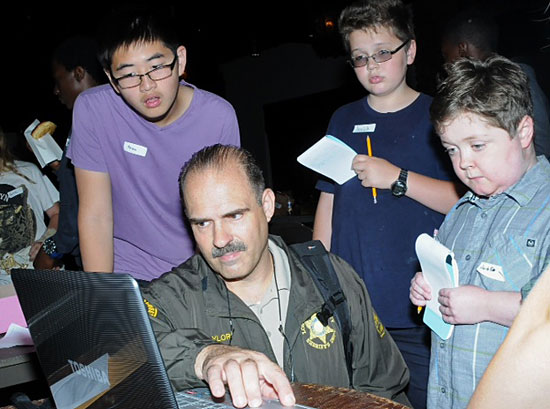
Sheriff's Det. Greg Taylor goes over a mock surveillance video with a group of young campers in June.
It’s been a while since his dad noticed the ad for the summer camp in the local Agoura Hills newspaper. Still, the experience made an impression on Max Bartolomea, now 17.
“It was a murder in a hotel room,” the Oak Park high school senior recalls, chuckling. “The body was gone but the room was still bloody. I loved it—I remember thinking it was exactly how it looked on TV.”
Now in its fifth year, the Los Angeles County Sheriff Department’s Teen C.S.I. Camp, complete with mock crime scenes, has evolved and expanded, but its impact on kids remains.
“It’s fun and they learn a lot,” says Deputy Scott Rule, who devised the camp curriculum in 2009 at the behest of Agoura Hills city officials. Then a member of the Juvenile Intervention Team at the Malibu/Lost Hills Sheriff’s Station, Rule has since taken the show to the sheriff’s Altadena station, where he’s now posted.
“It’s like getting to solve a mystery.”
Los Angeles County has summer diversions aplenty, from art camps at LACMA to nature adventures at the Natural History Museum.
But the sheriff’s Teen C.S.I. Camp has been a sleeper, locally available until now only through the City of Agoura Hills, where municipal officials inspired by crime scene investigation TV shows first floated the idea to the sheriff’s department.
“I actually had one of my own kids go the first year,” recalls Sheriff’s Lt. Jim Royal. “They did a mock murder. There was a preliminary lecture on technique, and then they did forensics—we had our print person come out, and the kids got to take notes and try to figure out who did it. After that first session, it was standing room only. It was a really great idea.”
Since then, sheriff’s officials say, the 5-day camp has steadily added features, though it always revolves around a single “crime.”
“That first year, we did a homicide in a party setting,” recalls Rule. “We used a mannequin for a victim and set it up in a room at a park that the city rented for parties. The murder weapon was an alcohol bottle.
“But we’ve done all sorts of things—one year we had a shooting victim, another year we had a stabbing. Once I even had a bar fight with a pool cue as a weapon. This summer in Altadena, it was a baseball bat.”
Each crime scene, he says, is carefully seeded with clues, from fingerprints to footprints to footage from security cameras. Then the campers, who range in age from 11 to 16, try to deduce whodunnit.
“We don’t make it graphic,” adds Rule, noting that the “victims” are rarely female and never children.
“We want it to be easy and solvable, not gory and bloody. We use plastic knives and the one year we did a gunshot victim, we used a plastic training gun. But every one of those cases are like scenes our detectives have been on—murder scenes, assault scenes, thefts, burglaries.”
The aim, he says, is to put forth a positive image for the department and to engage adolescents with technology that intrigues them (polygraphs, he says, are a guaranteed crowd pleaser.)
But, he adds, the camp also introduces teens to the range of potential careers in law enforcement, from crime lab work to prosecutions.
“I always try to find a local attorney to come out and play the District Attorney, so the kids can present their case and see what kind of charges they can get.”
This is the first year the camp has been offered at the Altadena station, Rule says. A $75 June session drew 23 youngsters—enough to prompt the addition of a second session from August 4-8. (For more information, click here.)
Meanwhile, in Malibu, sheriff’s officials say they had to tweak the curriculum slightly because the local forensic specialists who usually help guide campers were so occupied with real crime that they couldn’t participate without an overtime budget.
Instead of a C.S.I. Camp, the sheriff’s offering will be called “Secret Agent Camp” this year. The camp will run from August 11-14, and will be available through the City of Agoura Hills for $74. (Details are here.)
“We have our own fingerprint [technician] who works here already, and I supervised the crime lab for years, so we will still have a forensic element—it just won’t be as technical,” says Malibu/Lost Hills Lt. David Thompson.
Deputy Alicia Kohno, who has succeeded Rule, promises that the camp will still include all the usual, popular features—a murder, a crime scene, fingerprints, footprints, lie detectors.
Good, says Bartolomea.
Though the teen never aspired to a career in law enforcement—according to his mother, he’s headed later this summer to a USC program for potential medical students—one of his favorite things about the camp was its taste of serious police work.
“I remember thinking that it was really cool,” he says. “And really real.”
Posted 7/10/14
Not just a drop in the bucket
July 9, 2014
When it comes to quenching the water needs of a thirsty region, seemingly modest or far-flung efforts can come together to make quite a splash.
Witness a dozen local projects, from Agoura Hills to south Gardena, that just received an infusion of state grant funding totaling $23.4 million. Each initiative has a singular focus—creating bigger and better groundwater supplies in Pacoima, for instance, or installing curb screens in Calabasas to keep debris from flowing from city streets to the ocean.
But collectively, these endeavors add up to something greater than the sum of their parts: an integrated approach as diverse agencies come together to advance the kinds of water projects that will do the most good across the region.
As California’s drought makes headlines and prompts consideration of mandatory conservation measures, several of the projects have an extremely timely aim: retaining as much stormwater as possible to boost the region’s drinking water supply. Others focus on improving water quality, while some combine water initiatives with community recreation and beautification efforts.
Together, they’re the wave of the future, as the Los Angeles region looks beyond its Mulholland-era history and imagines a new approach to the next 100 years.
“It’s a new paradigm, a paradigm of cooperation and collaboration,” said Mark Pestrella, chief deputy director of the county’s Department of Public Works, which is overseeing the grant projects as leader of the Integrated Regional Water Management coalition in greater Los Angeles.
“There are 500 small water agencies in L.A. County alone, and probably six major water agencies, all talking to each other, reaching out to the communities that we serve and identifying projects that have the biggest community benefit,” Pestrella said.
The $23.4 million in Prop. 84 grant funding that was formally accepted by the Board of Supervisors this week is just one such infusion over the past decade. Since the collaborative water management model went into effect in California in 2002, nearly $100 million has been awarded to water resource agencies in the county, Public Works Director Gail Farber said. The state grant funds, she added, “go a long way towards ensuring a more sustainable water future for L.A. County.”
The endeavors awarded the grant funds approved this week include:
- The Pacoima Spreading Grounds Improvement Project, where new and updated equipment and improved stormwater storage will yield enough new drinking water to supply 42,000 Los Angeles residents for a year. Plans also are under consideration to create a park or open space on the grounds of an adjacent channel.
- Development of a second phase of Marsh Park in the Elysian Valley neighborhood near the L.A. River. The new design will convert industrial land into an open space park that also happens to collect and treat stormwater.
- Restoration of a 34-acre “flood retention basin” in the Upper Malibu Creek Watershed area.
- Design and construction of a 1¼-mile recycled water pipeline in south Gardena.
And, with California’s drought front and center, more help may be on the way soon. The state later this month is expected to issue a new round of grant funding devoted exclusively to drought-fighting projects.
An ambitious slate of 14 L.A. County projects seeking more than $28.8 million in funding has been submitted, with an emphasis on water recycling and replenishing groundwater. The overall goal of the drought-related projects is building the local water supply and reducing dependence on imports.
Posted 7/9/14
New LACMA design spans Wilshire
July 3, 2014
Two Los Angeles County museums’ unique but conflicting visions for the future were enough to send an internationally renowned architect back to the drawing board—literally. Now, after a collaborative process that included exploring the grounds of the La Brea Tar Pits with scientists, architect Peter Zumthor is back with a bold new approach for a signature building at the Los Angeles County Museum of Art that avoids the famed Ice Age fossil trove and instead creates a dramatic bridge across Wilshire Boulevard.
Zumthor’s new design for the most part preserves his original concept: a largely transparent building with a shape reminiscent of a curvaceous tar pit. But instead of constructing the entire 400,000-square-foot building on the Hancock Park campus that LACMA shares with the tar pits, he now proposes having one quarter of the structure reach south across Wilshire to what’s currently the museum’s Spaulding Avenue parking lot. One of the new building’s five distinctive glass pavilions—through which passersby will be able to see the museum’s art—would now be located on the south side of the boulevard.
A model of Zumthor’s original plan for the building was displayed last spring as part of a LACMA exhibit intended to inspire public conversation about the project. But Topic No. 1 in that conversation quickly became Natural History Museum officials’ concern that the proposed structure could obstruct future scientific discoveries hidden in the rich subterranean world of micro-fossils.
In the face of such worries, officials of both museums appeared before the Board of Supervisors last September and pledged to work together to preserve the tar pits while creating a new building that would replace several aging structures on the LACMA campus.
The current design, which still must obtain a range of environmental and governmental approvals in order to go forward, grew out of that process.
“Necessity is the mother of invention,” said Supervisor Zev Yaroslavsky, who has directed county funding to a feasibility study of the project that is now underway. The new design “is actually more iconic than his original design. It’s a win-win.”
“We think the design is much better,” agreed Michael Govan, LACMA’s director and CEO. He said the new approach opens up more park space around the tar pits, creates better vistas on a “continuous veranda” around the building and makes a more compelling visual statement by bridging Wilshire.
“It really becomes a landmark,” Govan said.
Zumthor had originally intended the design to be a “love letter to the tar pits,” but as criticism emerged about its possible negative impact on science at the site, he “joked that the tar pits didn’t love it back,” Govan said.
Well, that loving feeling appears to have returned.
“I think the results show that we all worked in good faith to both provide LACMA with an exciting building and to protect and preserve the tar pits,” said NHM director and president Jane Pisano, who walked the site with Zumthor and her team of scientists in February. “It was a chance to really talk to the person who had the challenge of coming up with the solution. I have to say, I was just very impressed by what a good listener he is.”
Museum officials have previously said that it will take a $650 million campaign to bankroll all elements of creating the new building. An updated figure, taking into account a potentially more complicated construction process, will not be available until the feasibility study is completed in the spring.
Meanwhile, though, the collaboration between the two county museums already is paying dividends.
“I personally have had a lot of fun getting to know in more depth the science of the La Brea Tar Pits,” Govan said.
As for Pisano, she said she always felt a good solution eventually would emerge.
“One of the things that I knew for sure was that architects, particularly good architects, thrive when they’re given very difficult design challenges,” Pisano said. “And I think that both the thriving and the design challenges were present in this case.”
Posted 6/24/14




